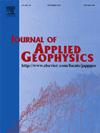Feasibility study of telluric magnetic field frequency selection method in groundwater exploration
IF 2.2
3区 地球科学
Q2 GEOSCIENCES, MULTIDISCIPLINARY
引用次数: 0
Abstract
Over the years, scholars have made significant contributions in the development of various electric pulse of a natural field methods, collectively referred to as frequency selection method (FSM). The methods still lacking the satisfactory exploratory theoretical studies for interpreting the results effectively. In a previous study, authors concluded that results obtained at several frequencies with both telluric electrical field frequency selection method (TEFSM) and telluric magnetic field frequency selection method (TMFSM) are affected by static shift effects. The present study is dedicated to the feasibility of the methods in groundwater exploration of karst aquifer applying two-dimensional forward simulations and field measurements. In the first stage, utilizing the magnetotellurics (MT) 2D forward modeling theory, authors computed the surface horizontal electric Ex and magnetic Hx field components along the survey line in both telluric magnetic (TM) and telluric electric (TE) polarization modes. Secondly, TEFSM was used where the measured curves of electric field at different frequencies were found well synchronized in depicting the abnormal position. Further, the field testing of audio-frequency magnetotellurics (AMT) conducted with V8 electric acquisition system considerably suppressed the interferences from anthropogenic noise sources. The synchronicity of magnetic field component curves at different frequencies was worse than that of electric field component. The simulation results indicated that the component Ex exhibited significantly high-value anomalies over high resistance bodies, whereas Ey and Hx components did not show clear anomalies. All three components displayed apparent anomalies for conductive bodies. Theoretically, TMFSM is a feasible approach for exploring shallow conductive abnormal bodies, although the component Hx is susceptible to external interference in practical applications. Therefore, designing specialized magnetic sensors with strong anti-interference capability and high-accuracy is a significant step towards achieving the satisfactory results.
求助全文
约1分钟内获得全文
求助全文
来源期刊

Journal of Applied Geophysics
地学-地球科学综合
CiteScore
3.60
自引率
10.00%
发文量
274
审稿时长
4 months
期刊介绍:
The Journal of Applied Geophysics with its key objective of responding to pertinent and timely needs, places particular emphasis on methodological developments and innovative applications of geophysical techniques for addressing environmental, engineering, and hydrological problems. Related topical research in exploration geophysics and in soil and rock physics is also covered by the Journal of Applied Geophysics.
 求助内容:
求助内容: 应助结果提醒方式:
应助结果提醒方式:


